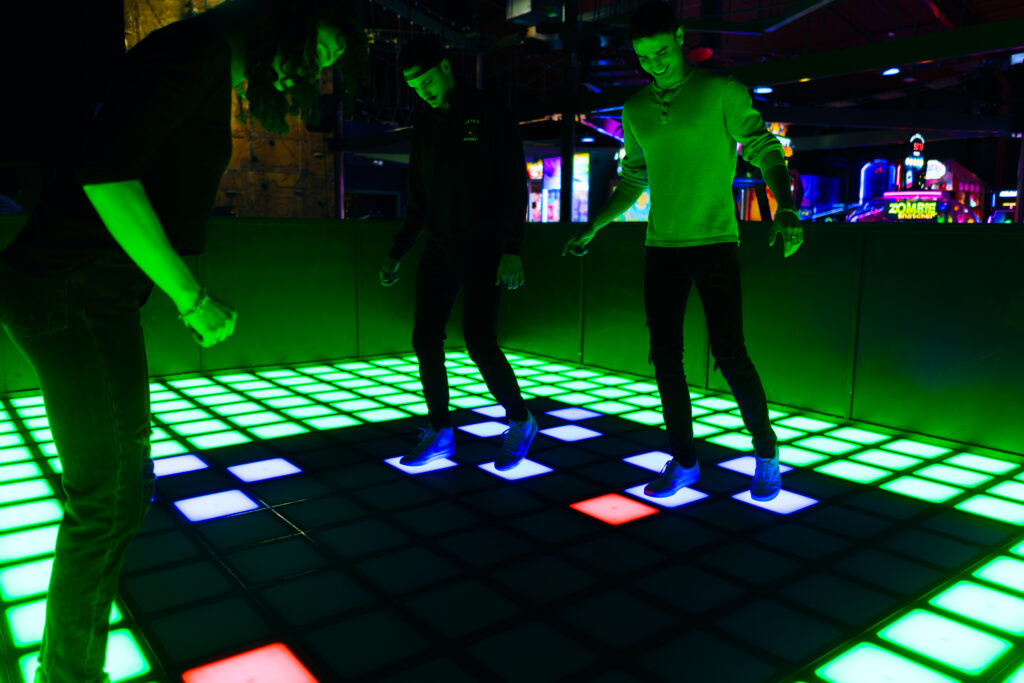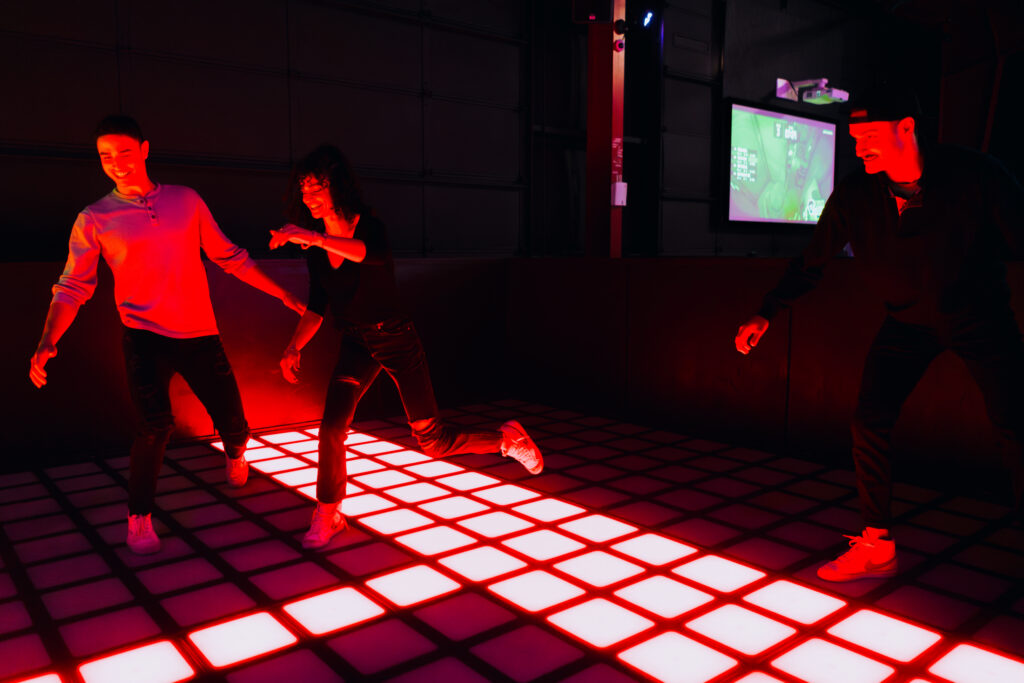Pixel Games
Bringing Classic Interactive Floor Gaming Fun to the Arcade
Immersive gaming, competitive socializing, active fun – buzzwords behind current trends to create attractions that get people out of their homes and into the game room, becoming more physically active while having fun with family and friends. Those are also attributes long held by laser tag attractions and now, a couple of those makers are branching out with interactive gaming floors.
One of those is Pixel Games, a company started by members of the Laserforce European team. They designed and engineered the product in Germany, creating a separate company and starting development in 2022. Interestingly, this team also now owns Laserforce, putting together a deal to buy it from owner and co-founder Len Kelly when he decided to retire.
Bringing it to the North American market are familiar faces. First, there’s Laserforce USA President Jeff Willy, who heads the company bringing Pixel Games to North America, Square Entertainment (a pixel is square, get it?). Then, there’s Laserforce Business Development Officer Chris Epstein and Noah Kline.

Players have fun with Pixel Games’ action. In this installation, a half wall separates the interactive game floor from the arcade, providing a way for spectators to enjoy the excitement. Scoring is recorded and visible within the attraction, letting players compete, trying to beat others’ scores.
“It’s an exciting time and there are a lot of synergies,” Willy said. “Now that the Pixel Games team also owns Laserforce, we’ll be at tradeshows together…something Amusement Expo showgoers might have noticed.”
Those at the show also most certainly noticed the Pixel Games attraction at their booth.
The product uses a floor of non-slip, color-changing, LED-lit tiles to create fun game play for kids and adults. It’s offered in larger-scale formats as well as a version called Pixel Arcade designed especially for – you guessed it – game rooms!
“At its core is a very simple concept best described by thinking about the old ‘the floor is lava’ game which has been around in many forms,” Willy explained. “Depending on what color the tile is, you either step on it or you don’t – for example, red tiles mean danger, but green ones are safe. It’s instinctive. After that, it becomes increasingly challenging for the players to make the combinations. Then, they really get into it, challenging each other to beat their score. It all just blends together really well.”
The system driving the indoor interactive gaming floor is self-controlled and automated. Just as the play is intuitive, so is the user interface, says the company. There’s no need for an attendant or a briefing session since players step up to the touchscreen game control terminal where they select their game and level of play. RFID cards or wearable Pixel Bands make it simple for them to buy time or credits. There is also a membership system to record stats and game details, the ability to level up, store achievements, collect customizable avatars and more.
For operators, the company says the user interface offers a robust set of controls allowing them to charge player cards or bands, create new members, set language and volume controls, etc. There is also “SUP,” a support and update program offering customer support by phone and email, a minimum of two updates per year, warranty, and replacement of any defective tiles (for up to three years) and more. Willy says installation is a breeze as well, often taking just a half-day or a few hours for the smaller setups. “Essentially, it’s like a picture frame on the floor filled with LED-lit squares inside,” he said.
Size-wise, Pixel Arcade is well-suited for FECs, bowling centers, laser tag facilities and the like, in sizes that range from 96 sq. ft. (8’ x 12’) to 192 sq. ft. (12’ x 16’). For those wanting a larger footprint than the Arcade version can accommodate, there are Pixel Games setups ranging from 210 sq. ft. (13’ x 16’) up to the maximum size of 520 sq. ft. (16’ x 32’). The recommended size is between 250 and 300 sq. ft., the company says.

Offering More Fun!
“Coming from the laser tag perspective, what’s key is to diversify and have more than one attraction,” Willy said. “Laser tag takes up a great deal of space so a very small footprint attraction like Pixel Arcade is a great fit. In operations, it’s also important that operators treat it like an ‘attraction,’ looking at it the same way they do laser tag, laser mazes, mini-golf, bumper cars and so on.”
Willy has first-hand operational experience with Pixel Games, running a 300-sq.-ft. version at his Loveland, Colo., laser tag center where he sets it to arcade-style timed play (90 seconds). It pairs nicely with his location’s laser mazes and motion simulator in support of the anchor attraction, he said. In Europe where competitive socialization has really taken hold, Willy said Pixel Games is often run as a larger attraction like laser tag, and is priced accordingly with multiple players booking the attraction in 20- or 30-minute sessions.
Regardless of size, he says it’s as fun to watch as it is to play so he advises operators to build it out so spectators can enjoy the action (and end up wanting to play themselves). “I built a half wall around mine so everyone in the location can stand around, lean on the wall and watch the fun.”
Willy was particularly impressed with a Michigan FEC’s Pixel Arcade installation where they enclosed it completely in glass. There’s also an escape room with it installed so it’s visible through the front windows, placed in the location’s lobby next to their leather couch. Talk about visibility! “Those solidified it for me that Pixel Games is truly a social experience,” he said, adding another facility “got really fancy and converted the entire party room floor to Pixel Games.
“However it’s set up, it’s really fun with the players challenging each other. You play a round and then the next person tries to beat you and so on. It reminds me of bowling where you reserve a lane for a set period of time and, while each person is bowling, the others are ordering drinks, food, watching, filming and putting clips on Instagram and Tik Tok. Pixel Games is a fun single-player game, but it’s a whole different story when you get to play with your friends.”
Willy said that the leveling-up of play, starting with an easy first level anyone can understand with subsequent levels increasing the challenges as they move up. By the end of it, there’s a really high level – I can’t even do it,” he laughed, “but it’s mesmerizing to watch someone who’s practiced and gotten really good at it. It’s incredible watching them just fly through the action, dodging the red tiles.”
“While other companies have offered interactive gaming floors, but what sets ours apart is the way it’s all put together as a package,” Willy said. “That’s what matters, as well as the way the gameplay feels. It’s important for us to be aggressive about releasing new content, because if people really get into it, they want new game play modes and levels. That’s going to be the key to this attraction’s longevity, and that’s where our software development team comes in – that’s what really is going make a difference in the long run. I feel like the sky’s the limit with the technologies we have access to.”
Pixel Games is available now and there are already a solid and growing number of installations worldwide. The first of those were in Europe but Willy says North America is catching up with a goal of 50 installations by year’s end. For more information, visit pixel-us.com.




